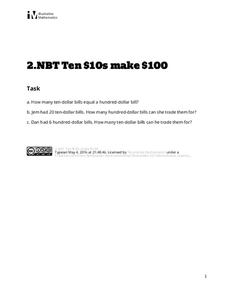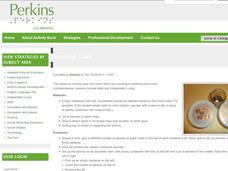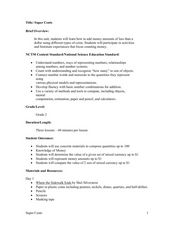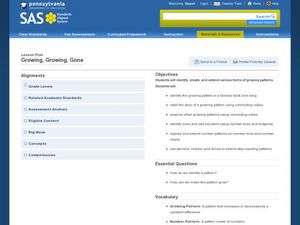Curated OER
Cents Sense
In this counting money worksheet, students solve 4 problems in which students are matched with their labeled piggy banks. Students read the clues and match the banks to each person.
Illustrative Mathematics
Ten $10s Make $100
If ten $10s make $100, then how much money do twenty $10s make? Young bankers find the number of bills required to make base ten amounts in three different word problems.
Arcademics
Dolphin Feed
Gather money with porpoise. Individuals click on a combination of coins and bills to match the displayed amount of money. Each collection feeds a dolphin, and the player that gathers the most correct amounts wins the online game.
Curated OER
"Money In My Pocket"
Second graders assess a brief history of money, the use of money, working with money as well as adding and subtracting with money and how to spend money wisely with responsibility. In addition, they discuss how everything belongs to God...
Curated OER
Nickels and Pennies
In this counting money worksheet, students find the value of the coins and count the coin with the greater value first. Students then complete the penny and nickel chart using the word problem.
Curated OER
Use a Picture
In this counting coins worksheet, students determine how much money is needed to buy the frog by completing the understand, plan, solve, and look back sections.
Perkins School for the Blind
Counting Cups
Teach one-to-one correspondence, fine motor, and counting skills to your learners with visual disabilities. Included are a set of activity suggestions, which are useful when teaching a variety of different early math skills. Braille,...
Curated OER
Rolling For Money
Second graders examine several coins to determine their values. Pennies, nickels, dimes, and quarters are counted. Music is added to the lesson to enhance the experience.
Pennsylvania Department of Education
How Many Ways?
Students estimate the amount of money they have in groups of pennies, nickels, and dimes. In this money lesson plan, students then count up the amounts they have and exchange money amounts.
Curated OER
Penny Counting
In this penny counting worksheet, students solve 4 story problems in which three digit numbers are added or subtracted. All problems pertain to pennies; there will be regrouping.
Curated OER
Addition Word Problems #1
Math is all around us, and scholars observe various addition scenarios as they solve 15 word problems. Each of these involve two-digit addends, some of which are money values. Although there are no decimals or fractions, learners do need...
Curated OER
Counting Money
Students read, write, and identify different coin combinations and use this information in real-world situations.
Curated OER
Super Cents
Second graders study money amounts less than a dollar. In this math instructional activity, 2nd graders practice counting coins. Students read various stories and discuss how money was used in the stories.
Curated OER
Counting Pennies (1)
In this pennies worksheet, students study the sets of pennies and add each penny. Students write the total number for each set on the blank line.
Curated OER
Counting and Making Change
In this mathematics worksheet, students solve various counting and money problems. They identify the quarter, dime, nickel, and penny, and how much each is worth. Students also add up the totals for various combinations of the currency...
Curated OER
Pennies, Nickels, and Quarters
In this coin counting instructional activity, students draw the amount of money for each problem and use the specific amount of coins given. Students use pennies, nickels, and quarters to solve the 5 problems.
Curated OER
Pennies, Nickels, and Quarters
In this coin counting worksheet, students identify the coins of pennies, quarters, and nickels and count the total amount of money for 5 problems.
Curated OER
The Price Is Right - TV Game Show
Students play variation of TV game show "The Price is Right" to identify coins and their values.
Curated OER
Penny Jar
Pupils collect pennies to donate to charity and calculate the number of pennies. In this penny counting lesson, students group pennies in tens and count how many dollars and cents they have. Pupils read a book about money. Students...
EdHelper
Dimes and Pennies
In this dime and penny instructional activity, students count coins and write their value beneath, then their total value. Worksheet is part of a subscription site with links and is labeled as a sample.
Curated OER
Pocketful of Change
For this math problem solving worksheet, students examine 4 price tags and mark the number of dimes and pennies needed to pay for each item. Students also respond to 1 math word problem.
Curated OER
How Much is that Name?
Students explore money counting. In this money problem solving lesson, students calculate how much money their name is "worth" using the corresponding alphabet letters which have been assigned a coin value.
Curated OER
Growing, Growing, Gone
Budding mathematicians identify growing patterns in numbers and songs then create their own patterns. They look at number patterns and language patterns and then create their own using money and footprints.
Curated OER
Counting Money
Pupils discover the importance of economics through Shel Silverstein's poem Smart. Students are introduced to the concept of earning money and using money to purchase necessary items, after becoming familiar with U.S. money.

























